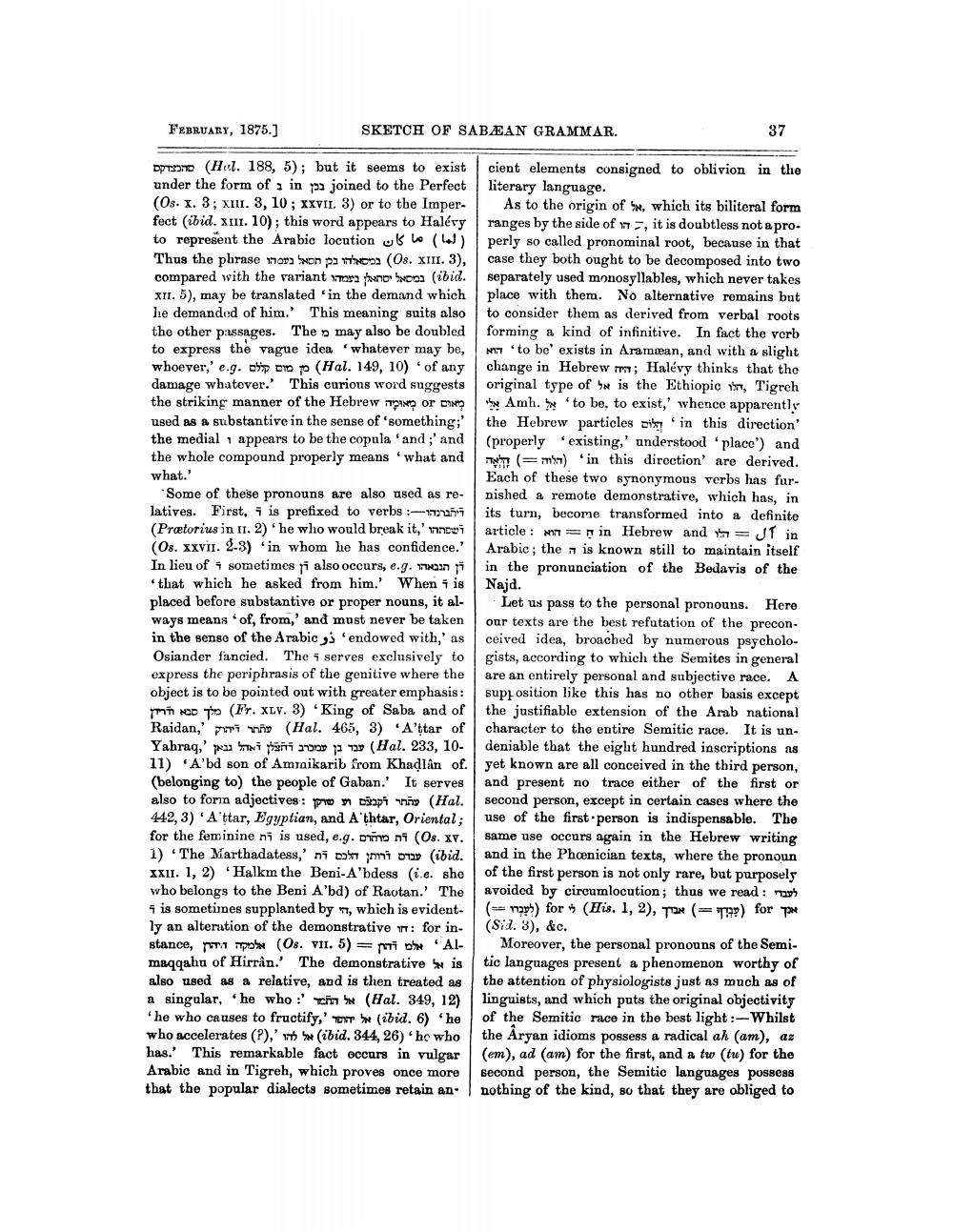________________
FEBRUARY, 1875.]
DPD (Hal. 188, 5); but it seems to exist under the form of a in pa joined to the Perfect (Os. x. 3; XIII. 3, 10; XXVII. 3) or to the Imperfect (ibid. XIII. 10); this word appears to Halévy to represent the Arabic locution ()
SKETCH OF SABEAN GRAMMAR.
,(3 .Os. XIII) במסאלהו בכן תשאל בעמהו Thus the phrase
compared with the variant or no co (ibid. XII. 5), may be translated 'in the demand which he demanded of him.' This meaning suits also the other passages. The may also be doubled to express the vague idea whatever may be, whoever,' e.g. op op (Hal. 149, 10) of any damage whatever.' This curious word suggests the striking manner of the Hebrew D or D used as a substantive in the sense of 'something;' the medial appears to be the copula 'and;' and the whole compound properly means 'what and what.'
Some of these pronouns are also used as relatives. First, is prefixed to verbs:-1727 (Prætorius in II. 2) he who would break it,' revi (Os. XXVII. 2-3) in whom he has confidence.' In lieu of sometimes i also occurs, e.g. man
that which he asked from him.' When is placed before substantive or proper nouns, it always means of, from,' and must never be taken in the sense of the Arabic, 'endowed with,' as Osiander fancied. The serves exclusively to express the periphrasis of the genitive where the object is to be pointed out with greater emphasis: THOD TO (Fr. XLV. 3) King of Saba and of Raidan,' (Hal. 465, 3) 'A'ṭtar of
-233,10 .Hal) עבד בן עמכרב והצלן לאה גבאן ,Yahraq
11) A'bd son of Ammikarib from Khaḍlân of. (belonging to) the people of Gaban.' It serves also to form adjectives: Daphn (Hal. 442, 3) Attar, Egyptian, and A'thtar, Oriental; for the feminine ni is used, e.g. Do ni (Os. XV. 1) The Marthadatess,' ni mi on (ibid. XXII. 1, 2) Halkm the Beni-A'bdess (i.e. she who belongs to the Beni A'bd) of Raotan.' The
is sometimes supplanted by, which is evidently an alteration of the demonstrative : for in
-Al אלם דהן = (5 .Os. VII) אלמקה היהון ,stance
is
maqqahu of Hirrån.' The demonstrative also used as a relative, and is then treated as a singular, he who (Hal. 349, 12) 'he who causes to fructify,' www (ibid. 6) 'he who accelerates (?),' (ibid. 344, 26) 'he who has.' This remarkable fact occurs in vulgar Arabic and in Tigreh, which proves once more that the popular dialects sometimes retain an
37
cient elements consigned to oblivion in the literary language.
As to the origin of ", which its biliteral form ranges by the side of, it is doubtless not a properly so called pronominal root, because in that case they both ought to be decomposed into two separately used monosyllables, which never takes place with them. No alternative remains but to consider them as derived from verbal roots forming a kind of infinitive. In fact the verb
'to be' exists in Araman, and with a slight change in Hebrew ; Halévy thinks that the original type of a is the Ethiopic, Tigreh
Amh. to be, to exist,' whence apparently the Hebrew particles in this direction' (properly existing,' understood 'place') and
(b) in this direction' are derived. Each of these two synonymous verbs has furnished a remote demonstrative, which has, in its turn, become transformed into a definite article in Hebrew and JT in Arabic; then is known still to maintain itself in the pronunciation of the Bedavis of the Najd.
Let us pass to the personal pronouns. Here our texts are the best refutation of the preconceived idea, broached by numerous psychologists, according to which the Semites in general are an entirely personal and subjective race. A supposition like this has no other basis except the justifiable extension of the Arab national character to the entire Semitic race. It is undeniable that the eight hundred inscriptions as yet known are all conceived in the third person, and present no trace either of the first or second person, except in certain cases where the use of the first person is indispensable. The same use occurs again in the Hebrew writing and in the Phoenician texts, where the pronoun of the first person is not only rare, but purposely avoided by circumlocution; thus we read: (ph) for (His. 1, 2), Tx (?) for p (Sid. 3), &c.
Moreover, the personal pronouns of the Semitic languages present a phenomenon worthy of the attention of physiologists just as much as of linguists, and which puts the original objectivity of the Semitic race in the best light :-Whilst the Aryan idioms possess a radical ah (am), az (em), ad (am) for the first, and a tw (tu) for the second person, the Semitic languages possess nothing of the kind, so that they are obliged to




